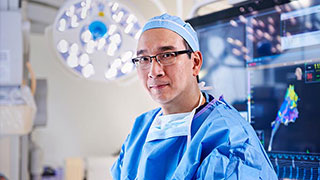Specialized Treatment for Rhinophyma
Rhinophyma is a skin disorder that causes the nose to enlarge and become red, bumpy, and bulbous. It is thought to result from untreated, severe rosacea, a chronic inflammatory skin condition that causes facial redness on the nose and cheeks.
It was once believed that rhinophyma was caused by heavy alcohol use, but that is not correct. Rhinophyma occurs equally in people who drink no alcohol and those who drink heavily. The condition can lead to permanent disfigurement if left untreated, and a large bulbous nasal tip can cause nasal obstruction.
Our experienced skin care specialists at UT Southwestern have years of training in dermatology and plastic surgery and are involved in research to improve the diagnosis and treatment of all types of skin conditions, including rhinophyma. We offer compassionate care and effective treatment that restores a natural appearance and improves quality of life for our patients.
Causes and Risk Factors of Rhinophyma
The exact causes of rhinophyma are unknown, but certain factors can increase the risk of this rare disorder. These risk factors include:
- Age: Rhinophyma is typically diagnosed between age 50 and 70.
- Gender: Men are more likely to develop the condition than women.
- Complexion: Fair-skinned people are more likely to have rhinophyma.
- Ethnicity: People with an Irish, English, Scottish, Scandinavian, or Eastern European background are at a higher risk.
- Family history: People with family members who have had rosacea or rhinophyma are at a higher risk.
Symptoms of Rhinophyma
Rhinophyma usually develops in more severe cases of rosacea. Its signs and symptoms can occur in cycles and become worse if left untreated. Signs and symptoms that affect the nose include:
- Gradual changes in appearance to a swollen, bulbous shape
- Many visible oil glands
- Enlarged skin pores
- Reddish skin color
- Thickened skin
- Waxy, rough, yellowish surface
Diagnosing Rhinophyma
Our experienced team conducts a thorough evaluation, which includes a:
- Physical exam
- Discussion of personal and family medical history
Usually, we can diagnose rhinophyma with this information, without the need for further testing. We sometimes perform a skin biopsy to confirm the diagnosis, especially in patients whose condition does not improve with treatment. In a biopsy, we take a small sample of skin cells to examine under a microscope.
Treatment for Rhinophyma
For rhinophyma, surgery is usually the main treatment to:
- Reshape a disfigured nose
- Remove tissue overgrowth
- Minimize enlarged blood vessels
- Improve appearance and breathing ability
Our cosmetic facial plastic, dermatologic, and plastic surgeons also treat rhinophyma with:
- Laser resurfacing to reshape the nose
- Dermabrasion using a small, rotating device to remove the top layers of skin
In more severe cases, treatment consists of shaving down the bulk of the tissue with a sharp instrument or surgical cautery and allowing the area to heal with monitored dressing changes. In rare cases, skin grafting may be needed. In large nasal tip rhinophymas, septorhinoplasty (reconstruction of the function of the nose) may be part of the treatment. Six months after a septorhinoplasty, patients may consider laser resurfacing.




